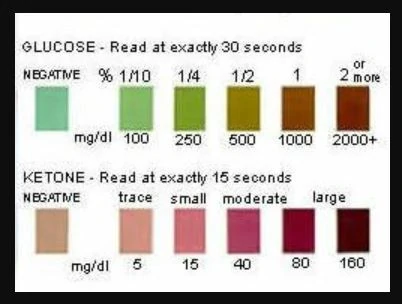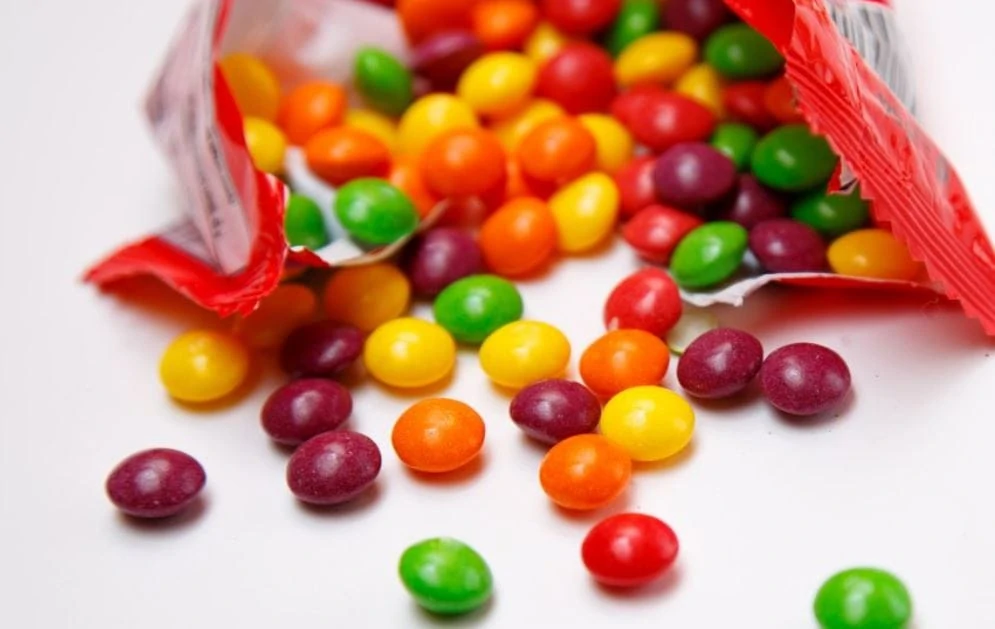Imagine you have just finished a long day, and you find yourself sitting in the living room watching one of the latest popular streaming dramas on your mobile device. As the opening credits begin, your dog walks into the room with a very sympathetic look in their eyes.
They eagerly tap the floor a few times with their front paws and let out a high-pitched wince. You feel obligated to hit the pause button and get your little mate a snack.
You reach for something sweet that you have lying nearby, a bag of Skittles. Dogs appreciate a little treat in between meals, and you’ve just got to give your four-legged friend something to munch on!

So Can Your Dog Eat Skittles?
The short answer is: No. Please do not feed your dog Skittles or any other kind of human candy. If your dog needs a snack, make sure to feed them treats that are specifically manufactured for canine consumption, not human-specific candies such as Skittles.
Now let us consult some dietary sources to find out in detail what is contained in one regular bag of Skittles.
What’s In A Bag Of Skittles?

Dietary reports indicate that Skittles contain very high levels of sugar; consumption of excess sugar has been consistently correlated with a higher risk of many digestive, endocrine, and dental diseases in dogs.
An important fact to remember is that sugars in your dog’s food can come in many forms, and a lot of these sugars are “refined” to make them even sweeter. This refinement process comes at the expense of any other nutritional value.
In a bag of Skittles, sugar is the primary danger to your dog’s health. A standard-sized bag of Skittles contains 191 grams of candy. The serving size indicated on the packaging is 40 grams.
In each serving, there are 160 calories, 1.5 grams of fat, and 30 grams of sugar. This means that for each individual Skittle, about 75% of its mass is just sugar! This totals out to roughly 143 grams of sugar in a standard-sized bag of Skittles.
To put that into perspective, a 350-milliliter can of regular Coca-Cola, the most common variety sold in grocery stores, contains the equivalent of 38 grams of sugar.
The refined sugar in Skittles is chemically-synthesized to maximize its calorie content, processing out any other nutritional value. As a result, dogs consuming Skittles are at a higher risk of developing obesity.
This can lead to a variety of secondary health effects such as skeletal support issues, problems with blood circulation, and detrimental changes in your dog’s metabolism. The extra pressure on the joints can potentially lead to fractures in your dog’s leg bones.
The extra weight placed on the heart and lungs can also increase the stress placed on those organs and thus degrade their healthy functioning.
What Happens If You Feed Your Dog A Bag Of Skittles?

Excess sugar consumption can increase your dog’s risk of tooth decay. As nearly all foods contain some sugar, it is important to ration your dog’s consumption of sugar from all sources.
The bacteria naturally present in your dog’s mouth consume sugar as a food source and excrete acidic compounds.
These acidic compounds gradually eat away at the enamel, the outer coating of your dog’s teeth, and thus increase your dog’s risk of diseases such as dental cavities.
Dogs require some carbohydrates in order to live, just like humans, but these carbs do not need to come from the sugar-dense, empty calories of a bag of Skittles. Depending on the rate of consumption, an excess of sugar can lead to inflammation in various areas of the dog’s body.
The excess sugar can build up in the dog’s gut and upset the delicate balance of micro-organisms, which enable the dog’s digestive system to function properly; this may lead to vomiting or diarrhea.
This occurs because the dog’s inner ecology of gut microorganisms is trying to rebalance itself; it must purge the bacterial growth, which has grown excessively from consuming excess sugar.
The presence of so much sugar also makes Skittles a food item with a very high glycemic index. The glycemic index is a term used by veterinary professionals to indicate the degree to which a food item impacts your dog’s blood sugar.
If the pancreas has to produce a very high amount of insulin to counteract the excess sugar, your dog’s bloodstream may eventually lose its reactivity to insulin. Sugar then will remain unprocessed in your dog’s bloodstream, increasing the risk of developing Type II diabetes.
This is a condition where your dog’s pancreas can no longer produce enough insulin to absorb the glucose in their bloodstream. It is possible to test your dog for their risk of developing Type II diabetes with the use of urine glucose and ketone tests.

Within the United States, the rate of diabetes among dogs has more than tripled since 1970. It now affects roughly one out of every 160 dogs in the country. There are visible signs if your dog is at risk of developing Type II diabetes. These include excessive thirst, increased urination, and weight loss with normal food consumption.
Dogs at risk of developing Type II diabetes may also show signs of vision loss, such as running into objects. This is a sign of the development of cataracts. Cataracts are the term for when the lens of an eye becomes clouded.
This can occur due to swelling of the lens from excess sugar in your dog’s bloodstream. About eighty percent of canine diabetic patients develop cataracts within 16 months of diagnosis. As an additional factor to keep in mind, the risk of cataracts rises with age, regardless of your dog’s sugar consumption.
However, cataracts caught at an early stage have the highest rate of success in surgical removal. Late-stage cataracts are visible due to uveitis, an inflammatory condition that causes eye pain, eye redness, and pupil constriction. If the cataract surgery is performed before the onset of uveitis, the typical success rate is 95%.
The life expectancy of a dog with diabetes can be the same as any other, provided that you and your local veterinarian properly manage your dog’s condition.
The first six months are typically the riskiest due to the chance of developing secondary disorders as a result of diabetes, but the condition is known to stabilize after this period. For the management of diabetes after this point, the dog must be provided with the proper amount and type of insulin and fed a diabetic-friendly diet.
How Can You Protect Your Dog’s Teeth From The Effects Of Excess Sugar?

To protect your dog’s teeth against the effects of excess sugar consumption, it is necessary to regularly brush their teeth. Brushing your dog’s teeth also protects them from a harmful buildup of bacteria and food debris along your dog’s gum line.
These bacteria can potentially transfer into your dog’s bloodstream through the gums. This places extra stress on organs that filter your dog’s blood, such as the kidneys. Good dental health is important for the health of your dog’s entire body.
However, it is not safe to use the kind of toothpastes formulated for human teeth for cleaning the teeth and gums in your dog’s mouth. Many varieties of human toothpaste contain xylitol. This is an artificial sweetener which is also present in sugar-free cookies and candy.
Xylitol is a dangerous toxin for dogs. Consumption of xylitol by your dog will stimulate their pancreas to release insulin as if they have consumed actual sugar, not a sugar substitute. As the insulin absorbs any glucose present in your dog’s bloodstream, it can lower your dog’s blood sugar to dangerous levels.
This is a state known as hypoglycemia. Xylitol can also harm the functioning of your dog’s liver, reducing their body’s ability to properly process any fats in their diet. It is important for your dog’s dental health that you provide a toothpaste that can clean your pet’s teeth of plaque, tartar, and stains, as well as freshening their breath, without the use of xylitol.
Be sure to look in pet stores or in the pet aisle of your local supermarket to find these products. The people who work there love animals too. They will be happy to point you in the right direction!
In Conclusion…

The consumption of excess sugar can lead to many serious medical complications for your dog. A bag of Skittles is not a preferable choice when your little friend needs a snack. Instead, reach for the bag of specially-formulated doggy treats.
This article was not written by a medical professional and does not prescribe treatment of any disease. If you think your dog requires medical treatment, please seek the help of your local veterinarian immediately.
INFO SOURCES:

